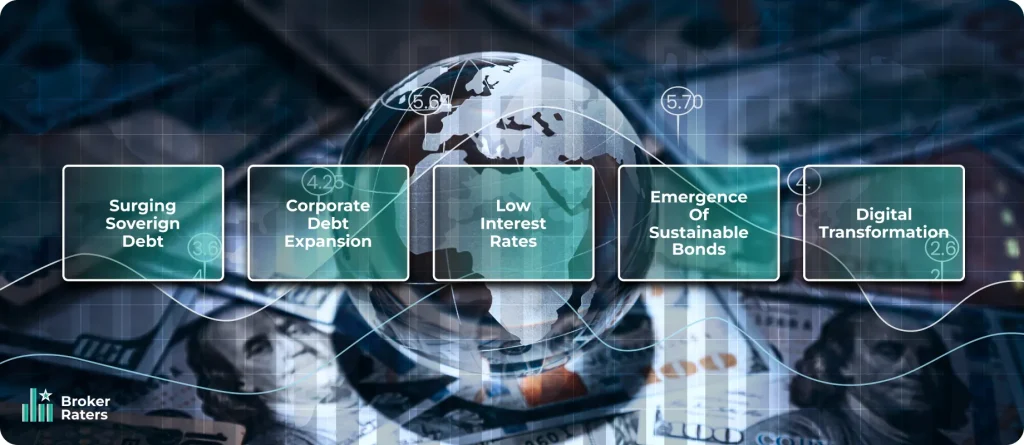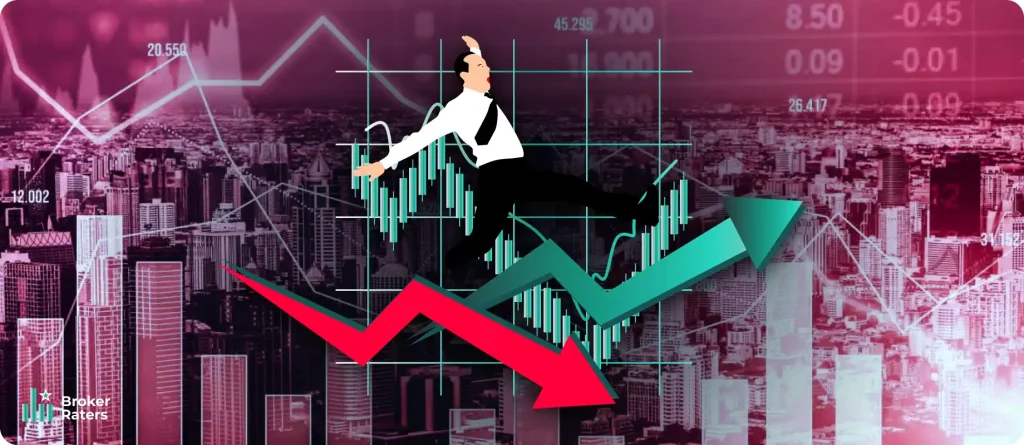Claire Maumo has experience in investment banking, strategic consultancy, and journalism. She has a Bachelor’s degree in Business Management and a Master’s in finance. She has a knack for making complex concepts easy to understand. Her primary focus is on crypto, blockchain, and financial instruments. Follow her for expert insights on trading and investment.
We may receive compensation from our partners for placement of their products or services, which helps to maintain our site. We may also receive compensation if you click on certain links posted on our site. While compensation arrangements may affect the order, position or placement of product information, it doesn’t influence our assessment of those products.
Governments, corporations, and institutions raise capital by borrowing from the global debt market. This market is crucial to the financial system. It is where debt instruments, like bonds, are traded. It also provides an investment avenue for lenders who earn interest on their money.
Bonds are low-risk investments for several reasons. First, the bond market earns a fixed stable income than stock market returns. Second, bondholders are prioritized over shareholders if a company runs into financial trouble. But, bond returns are usually lower compared to stocks and mutual funds.
Unlike the equity markets that trade stakes in companies, debt markets focus on lending and borrowing money. Investors in debt markets often seek stability and predictable returns. Let’s explore the debt market and its key trends, risks, and opportunities.
Debt Markets Meaning

Debt markets are where debt instruments trade. They link borrowers and lenders, allowing the flow of capital to promote investment. Borrowers issue securities to raise capital. Investors buy these securities for regular interest payments. When the money matures, the borrower repays the full amount. These regular interest payments are known as coupons.
The capital raised here may be for business operations in the case of a corporation. For the government, it may be for infrastructure development and other projects.
The traded debt instruments include:
- Government bonds
- Treasury bills
- Certificate of Deposits (CDs)
- Corporate bonds
Debt markets are into two main categories:
1. Government Debt Markets
Governments issue debt instruments to fund their activities. The government here could be central and local governments. They issue the securities to address fiscal deficits. For the central or federal government, it’s the central bank that issues sovereign securities.
Government debt securities are widely considered low-risk investments. They are also more liquid than corporate bonds.
When the government needs a short-term loan, it issues Treasury bills.
2. Corporate Debt Markets
Corporate bonds are debt instruments private companies issue to fund their business needs. These needs could be new projects, growth, or daily operations. These bonds carry varying levels of risk, with ratings reflecting the company’s financial health.
Types of corporate debt include:
- Corporate bonds
- Debentures
- Public sector unit (PSU) bonds
- Financial institution bonds
Key Trends in Global Debt Markets

A favorable funding environment has led to a surge in bond issuance. We have seen more capital flowing into lower-rated governments, often considered riskier segments. By the end of 2023, the total value of sovereign and corporate bond debt had reached nearly USD 100 trillion. That’s almost equivalent to global GDP. OECD projects this growth to rise to USD 56 trillion in 2024, marking an increase of USD 30 trillion since 2008.
The global debt market has experienced significant changes but the following key trends are shaping its future:
- Surging Sovereign Debt
The world has faced two major crises over the past two decades. First, came the 2008/09 financial crisis and then the COVID-19 pandemic. Each crisis led governments into a spending spree, leading to expanded government debt. The World Bank reports that federal borrowing has increased since the global financial crisis. Though it surged across the board, higher increases were in emerging markets and developing economies (EMDEs).
As of 2023, total sovereign bond debt stood at approximately USD 56 trillion. A significant portion of this increase has been in OECD countries, with the United States and China accounting for a large share.
- Corporate Debt Expansion
Corporate bond debt also saw significant growth, reaching USD 34 trillion at the end of 2023. This outstanding amount rose from USD 21 trillion in 2008. Notably, over 60% of the increase since 2008 came from non-financial corporations. So, it’s telling that there’s a global trend towards more corporate borrowing.
- Low Interest Rates
Low interest rates have defined global debt markets in recent years. Major economies have kept interest rates near zero to stimulate borrowing and investment. This environment has encouraged companies and governments to take on more debt. But low interest rates also mean lower returns for investors, leading them to seek higher yields in riskier bonds.
- Emergence of Sustainable Bonds
Projects aimed at combating climate change have increased over the years. Such projects include clean energy and sustainable agriculture. To fund them, the government issues green bonds. Investors who align their portfolios with social and environmental goals find these bonds attractive. By the end of 2023, the total amount of corporate and sovereign sustainable bonds outstanding was USD 4.3 trillion.
- Digital Transformation
For many years, despite technological advances, the debt market has largely remained unaffected. Take for example the World Bank, which since 1944 has raised nearly $1 trillion for sustainable projects through bonds. But its bond issuance and processing have remained analogue. But now, blockchain technologies like distributed ledger technology (DLT) and CBDCs promise change. We have financial institutions experimenting with blockchain-based bond issuance. This could help streamline processes, reduce costs, and increase transparency and risk mitigation.
The World Bank successfully issued a €100m digital bond on October 23rd, 2023. It used Euroclear’s Digital Financial Market Infrastructure (D-FMI). This was the first time the debt market systems have used blockchain technology in a regulated setting. This success demonstrates no regulatory changes are necessary to fully adapt the digital platforms. This move could motivate central banks and regulators worldwide and inspire a major shift.
Automation through the use of smart contracts could further simplify bond trading. It could simplify payment flows and settlements. If fully integrated, the global debt market will be more inclusive.
Risks in Global Debt Markets

Higher long-term real interest rates, lower growth, and rising debt pressure financial stability. These are the obvious risks in the global debt market. Inflation-adjusted interest rates are now well above post-global financial crisis lows.
Even though medium-term growth remains weak, persistently high interest rates increase debt costs. This adds to fiscal pressures and risks financial stability.
To manage these issues, decisive and credible fiscal actions are necessary. But the answer is always to gradually reduce global debt to sustainable levels and can help mitigate these challenges.
Rising Inflation
Rising inflation erodes the value of fixed-income investments, making bonds less attractive. Central banks may raise interest rates to combat inflation. But this act lowers bond prices and complicates decision-making for issuers and investors.
Sovereign Debt Crises
Weak economic growth and reliance on foreign or short-term debt can lead to defaults. If that happens, it can disrupt global debt markets and affect investor confidence. The World Bank has noted that there has been a high cost of borrowing that could threaten economic growth.
In January, international bond sales from emerging markets hit a record $47 billion. Stable economies like Saudi Arabia, Mexico, and Romania led the way. Riskier issuers now tap higher lending rates. For example, Kenya recently issued a new international bond with an interest rate higher than 10%. Experts often view interest rates above 10% as unaffordable for borrowing. This high rate reflects increased borrowing costs that can strain the country’s finances.
The World Bank’s deputy chief economist Ayhan Kose said countries should grow much faster to handle these costs. However, achieving such growth might be challenging.
Credit Quality Deterioration
High corporate debt and increased borrowing have lowered credit quality. Many investment-grade bonds are now just above non-investment grade. In 2023, over 53% of all investment-grade bonds were rated BBB, with companies issuing these bonds showing higher leverage. Although ratings suggest low default risk, poor sales can easily tilt the fortunes. Poor economic conditions could lead to downgrades and forced sales, impacting investors who rely on bond ratings.
Geopolitical Uncertainty
Geopolitical tensions and trade wars cause bond price fluctuations and currency depreciation. Political instability in key economies impacts the government and increases volatility in debt markets.
Opportunities in Global Debt Markets
The global debt markets present many opportunities. They include:
Debt markets help investors to reduce exposure to the volatility of equity markets. Bonds are an attractive option for those seeking lower-risk investments. They provide steady income through coupon payments. So, in times of market uncertainty, bonds can be your safe haven.
While emerging markets pose risks, they also offer significant growth potential. Many developing countries are expanding rapidly. They need to fund infrastructure projects, creating investment opportunities in emerging market bonds. Investors willing to accept higher risk can find attractive yields in these markets.
Environmental, Social, and Governance (ESG)-focused debt instruments are becoming more popular. Sustainable bonds allow investors to support green and social initiatives. There has been a pressing need for governments to fund low-carbon projects. This market will continue growing as the world seeks sustainable financing options.
Technology is opening new doors in the debt market. Blockchain technology offers the potential for more efficient bond issuance and trading. The innovations could pave the way for more decentralised debt markets for P2P transactions. This could make the debt market more affordable, transparent, and accessible to a wider range of investors and issuers.
Conclusion
The global debt market is a complex yet essential component of the financial system. It offers opportunities for growth, diversification, and innovation. But, like in investments, there are risks. Investors and issuers must remain vigilant and adaptive as debt levels rise. For investors seeking stable returns, the debt market remains an attractive option.
Emerging market debt, sustainable financing, and tech advancements are reshaping the debt market. We will be here as it unfolds. Stay with BrokerRaters.com for expert reviews and insights. Explore our in-depth analysis to make informed investment decisions.
